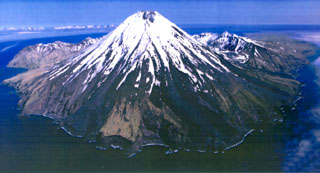Report on Kanaga (United States) — February 1994
Bulletin of the Global Volcanism Network, vol. 19, no. 2 (February 1994)
Managing Editor: Richard Wunderman.
Kanaga (United States) Intermittent steam-and-ash emissions
Please cite this report as:
Global Volcanism Program, 1994. Report on Kanaga (United States) (Wunderman, R., ed.). Bulletin of the Global Volcanism Network, 19:2. Smithsonian Institution. https://doi.org/10.5479/si.GVP.BGVN199402-311110
Kanaga
United States
51.923°N, 177.168°W; summit elev. 1307 m
All times are local (unless otherwise noted)
Intermittent venting of steam and ash continued in February and March. Observers in Adak . . . reported ash-rich plumes reaching hundreds of meters above the . . . summit on 18 February. Satellite images confirmed the presence of ash in the plume emitted from the cone. Continued minor, low-level steam-and-ash venting was reported by airline crews and ground observers on 21 February. Observers in Adak reported steam plumes coming from near-summit fumaroles on 4 March. Overcast conditions at the summit masked any possible ash emissions in late February and early March. Observations of fresh snowfall did not reveal any new ash deposits. Although ground observations from Adak were limited, a pilot reported a short-lived steam-and-ash burst on the afternoon of 10 March.
Geological Summary. Symmetrical Kanaga stratovolcano is situated within the Kanaton caldera at the northern tip of Kanaga Island. The caldera rim forms a 760-m-high arcuate ridge south and east of Kanaga; a lake occupies part of the SE caldera floor. The volume of subaerial dacitic tuff is smaller than would typically be associated with caldera collapse, and deposits of a massive submarine debris avalanche associated with edifice collapse extend nearly 30 km to the NNW. Several fresh lava flows from historical or late prehistorical time descend the flanks of Kanaga, in some cases to the sea. Historical eruptions, most of which are poorly documented, have been recorded since 1763. Kanaga is also noted petrologically for ultramafic inclusions within an outcrop of alkaline basalt SW of the volcano. Fumarolic activity occurs in a circular, 200-m-wide, 60-m-deep summit crater and produces vapor plumes sometimes seen on clear days from Adak, 50 km to the east.
Information Contacts: AVO.

